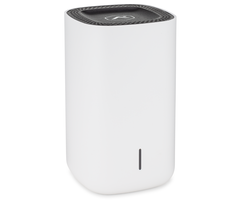Issues Using Qolsys IQ Panel 2 Plus as Secondary Z-Wave Controller
Posted By Michael GorisUpdate: This issue was even more severe than initially realized. The Qolsys IQ Panel 2 Plus offers no functionality as a secondary Z-Wave controller. More information on the subject is outlined in this FAQ.
We have learned of a flaw affecting the Qolsys IQ Panel 2 Plus and its Z-Wave functionality. The system cannot be used as an effective secondary Z-Wave controller with another Z-Wave hub. This issue has been confirmed on FW Version 2.5.4,and earlier versions are also likely affected.

If you are unaware of how a secondary Z-Wave controller works, it is basically a method to give you multiple points, or hubs, for controlling a Z-Wave network. When setting up a device as a secondary Z-Wave controller, you start by clearing all Z-Wave devices from that hub. All Z-Wave devices should instead be paired with the main hub, which will be the primary Z-Wave controller. You then pair the secondary controller to the primary controller. By doing this, all the Z-Wave devices associated with the primary controller will be pushed over to the secondary controller so that they can be controlled from both devices. Making the IQ Panel 2 System a secondary controller is a popular choice when using the system alongside Samsung SmartThings, Vera, and a selection of other Z-Wave controllers and hubs.
However, we have discovered that when the IQ Panel 2 is made a secondary controller, users are unable to control any devices that have been pushed over from the primary hub. The process will appear to be working, as the IQ2 System will successfully join the other Z-Wave network, but no control will be available for the Z-Wave devices pushed over to the system from the primary controller. Basically, these Z-Wave devices cannot be controlled from the IQ Panel 2 System, nor can they be controlled from the Alarm.com platform. This makes the IQ Panel 2 effectively useless as a secondary Z-Wave controller. We have confirmed that this problem exists on IQ Panel 2 Firmware Version 2.5.4. It is also believed that earlier firmware versions also carried this same issue. But we are unsure which was the first version to experience this problem.
Alarm Grid would like to apologize to anyone affected by this issue. We have already reached out to Qolsys to make them aware of the problem and to learn about a possible fix. Unfortunately, we have not received any word from Qolsys on when a fix would be released. We are hopeful that something in upcoming Firmware Version 2.6.0 may correct this issue, but we have not received any indication from Qolsys that such a fix will be implemented. This means that it may be impossible to use the Qolsys IQ Panel 2 or IQ Panel 2 Plus as a secondary Z-Wave controller for the foreseeable future. Please note that this issue is not believed to have any impact on the primary Z-Wave functions of the system.
We understand that not being able to reliably use the Qolsys IQ Panel 2 Plus as a secondary Z-Wave controller will be a major concern for some users. If you are looking for a panel that has proven to work reliably and consistently as a secondary Z-Wave controller, then we want to give special recommendation to the Honeywell Lyric Alarm System. We have seen the Lyric work wonderfully as a secondary Z-Wave controller when paired with a variety of popular home automation hubs. You might consider the Lyric as an alternative to the IQ Panel 2 Plus if secondary Z-Wave functionality is particularly important to you.
If you have any questions about this issue, or if you are an Alarm Grid monitored customer experiencing any unrelated problems or issues, please email our support team at support@alarmgrid.com. We will work to provide you with a quick and effective solution so that you can continue to get the very most out of your monitoring service. This is also a good email to use if you are interested in starting any new monitoring service with Alarm Grid. Remember, we are here from 9am to 8pm ET M-F to answer any questions or inquiries you might have. We look forward to hearing from you!






